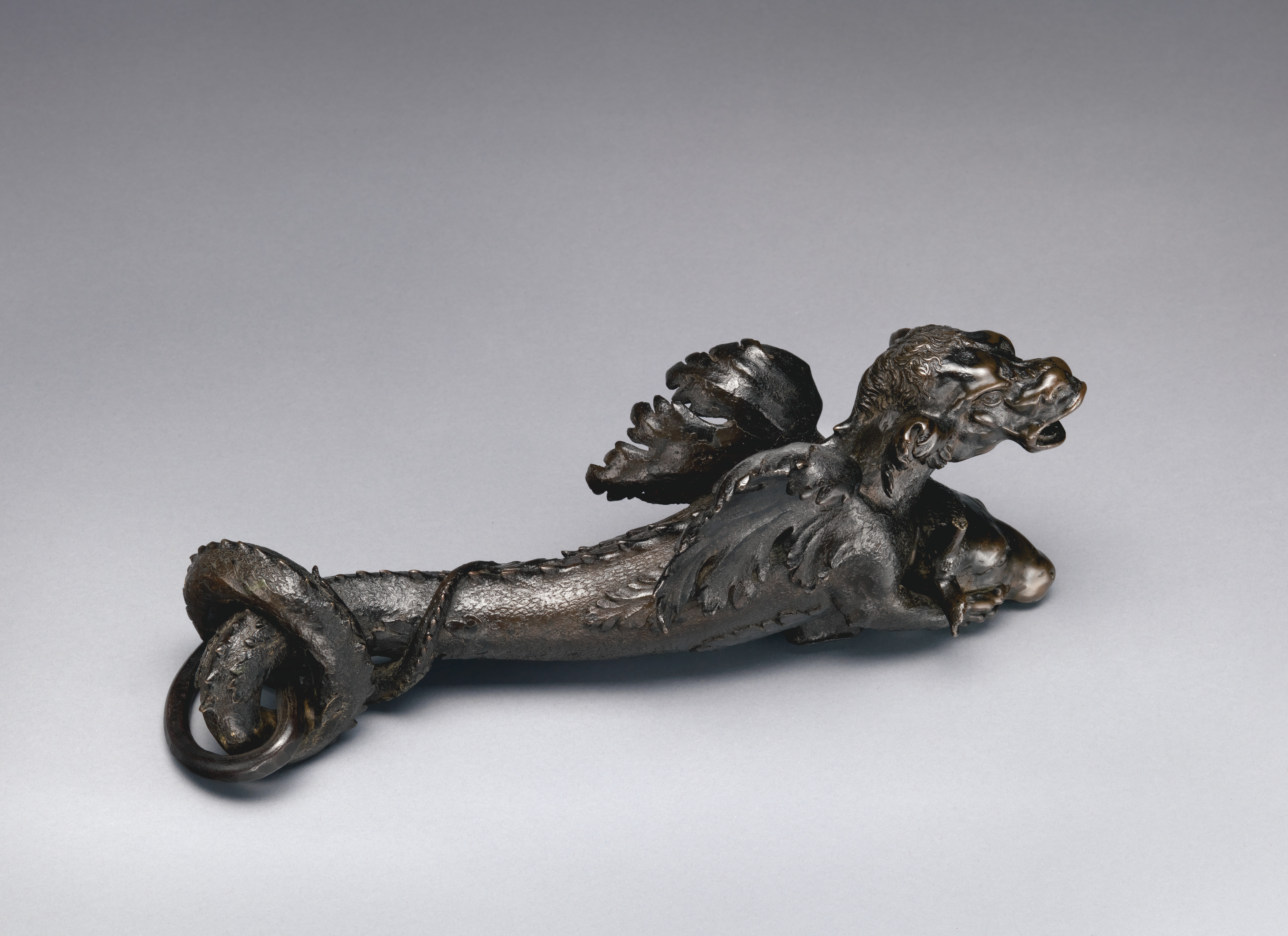Doorknocker
This doorknocker is comprised of a dog-headed creature with foliate wings riding a bull, its sinuous serpentine body culminating in an elegant knot. The bronze is one of at least eight extant similar knockers, though the sole example to feature a cynocephalic being, often considered barbaric figures in both Western and Eastern mythologies.[1] Other related bronzes, including well-known examples in the Rijksmuseum, the Cleveland Museum of Art, and one formerly in the Abbott Guggenheim collection, show devilish male faces lost amid leafy masses.[2]
The dating and authorship of these doorknockers remain largely unclear. Though the Cleveland bronze, published by Leo Planiscig as by Riccio when it was in the collection of Ernö Wittmann, has been considered one of the finest and perhaps the prototype for many related works, it is now dated to the nineteenth century.[3] Indeed, many such doorknockers once considered sixteenth-century in origin seem to have been produced in Italy during the 1800s, with a number exported to England and installed on the doors of pubs.[4]
The Linsky bronze was first exhibited and published by Wilhelm von Bode in 1898. Its modeling, manufacture, and provenance all sustain its Renaissance dating. Many of the details are delicately modeled in the wax, like the dog’s mop of curls, the subtle scaling on the creature’s body, and the fantastical floral ornament on its back. The wear on the two heads suggests centuries of use.
In 1984, James David Draper posited a Venetian origin for the doorknocker. Planiscig had cited an engraving from Francesco Colonna’s Hypnerotomachia Poliphili, published in Venice in 1499, as a possible source for the type.[5] The Linsky bronze was formerly in the collection of Count Friedrich von Pourtalès, German ambassador to the Russian Empire, who likely brought it to Saint Petersburg during his tenure there from 1907 to 1914. Though the bronze’s earlier provenance is unknown, the count’s father, Wilhelm, acquired Italian bronzes directly from Venetian palaces during his time in the city, and it is possible this doorknocker was purchased there.[6]
-JF
Footnotes
(For key to shortened references see bibliography in Allen, Italian Renaissance and Baroque Bronzes in The Metropolitan Museum of Art. NY: The Metropolitan Museum of Art, 2022.)
1. See Camins 1988, p. 29 n. 1, for a list (which includes cat. BOC519), divided into five variants. 2. Rijksmuseum, BK-16935 (Leeuwenberg 1973, p. 382, no. 645); CMA, 1948.487. The ex-Abbott Guggenheim doorknocker was sold at Sotheby’s, New York, January 27, 2011, as 19th century; see Camins 1988, pp. 29–30, cat. 6.
3. Planiscig 1927, fig. 446.
4. See Camins 1988, p. 29 n. 1, citing communication from Anthony Radcliffe.
5. Planiscig 1927, p. 265, fig. 302.
6. Wilhelm von Pourtalès purchased the large bronze statuettes of Neptune and Mars, formerly attributed to Sansovino, from the Palazzo Rezzonico, Venice, now in the Detroit Institute of Arts; see E. Richardson 1949–50, p. 61.
Due to rights restrictions, this image cannot be enlarged, viewed at full screen, or downloaded.
This artwork is meant to be viewed from right to left. Scroll left to view more.



